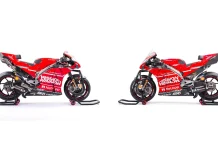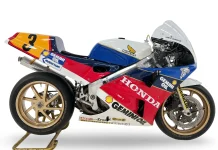
Using Dainese’s patented D-Skin leather—a dramatically softer cowhide treated with special wax and silicone—the Laguna Seca P.B. suit immediately feels pliable and comfortable, and its tacky surface grips the seat and other touch points well. The fit of the bi-axial elasticated panels inside my arms and at the back of my knees is excellent, and prevents that uncomfortable bunching when in a racing stance
Safety features include soft inserts around the torso and composite body armor protection. Despite no obvious venting, the Laguna Seca P.B.’s cooling is effective, partly due to air flow coming through the fabric parts of the suit—away from any stitching—and also from the Dainese Microclimate system, which includes a hypo-allergenic Sanytized lining.





